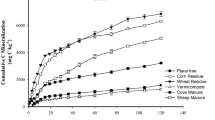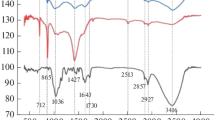Abstract
The aim of this work was to assess and compare the influence of Eisenia foetida Savigny earthworms on C mineralization rate, labile C fractions (water-soluble C and water-soluble carbohydrates), microbial biomass C, and enzyme activities (dehydrogenase, urease, phosphatase and β-glucosidase) in three soils of varying texture treated with a composted organic residue and cropped with Avena sativa L. Mineralization decreased with the addition of earthworms to the sandy and clay-loam soils, especially in sandy soil (by about 4 μg CO2-C g−1 day−1). There were no significant effects on the amount of CO2 evolved from clay soil due to the addition of E. foetida. The addition of E. foetida to sandy soil significantly decreased microbial biomass C and increased microbial metabolic quotient the qCO2 (CO2-C to biomass C ratio). The addition of E. foetida did not affect the microbial biomass or the qCO2 of the clay-loam and clay soils.

Similar content being viewed by others
References
Ajwa HA, Rice CW, Sotomayor D (1998) Carbon and nitrogen mineralization in tallgrass prairie and agricultural soil profiles. Soil Sci Soc Am J 62:942–951
Anderson TH, Domsch KH (1993) The metabolic quotient for CO2 (qCO2) as a specific activity parameter to assess the effects of environmental conditions, such as pH, on the microbial biomass of forest soils. Soil Biol Biochem 25:393–395
Bohlen PJ, Edwards CA, Zhang Q, Parmelee RW, Allen M (2002) Indirect effects of earthworms on microbial assimilation of labile carbon. Appl Soil Ecol 20:255–261
Boyer J, Michellon R, Chabanne A, Reversat G, Tibere R (1999) Effects of trefoil cover crop and earthworm inoculation on maize crop and soil organisms in Reunion Island. Biol Fertil Soils 28:364–370
Brink RH Jr, Dubach P, Lynch DL (1960) Measurement of carbohydrates in soil hydrolysates with anthrone. Soil Sci 89:157–166
Caravaca F, Hernández MT, García C, Roldán A (2002a) Improvement of rhizosphere aggregates stability of afforested semi-arid plant species subjected to mycorrhizal inoculation and compost addition. Geoderma 108:133–144
Caravaca F, Masciandaro G, Ceccanti B (2002b) Land use in relation to soil chemical and biochemical properties in semi-arid Mediterranean environment. Soil Till Res 68:23–30
Carter MR, Angers DA, Kunelius HT (1994) Soil structural form and stability, and organic matter under cool-season perennial grasses. Soil Sci Soc Am J 58:1194–1199
Ceccanti B, Garcia C (1994) Coupled chemical and biochemical methodologies to characterize a composting process and the humic substances. In: Senesi N, Miano T (eds) Humic substances in the global environment and its implication on human health. Elsevier, New York, pp 1279–1285
Ceccanti B, Pezzarossa B, Gallardo-Lancho FJ, Masciandaro G (1994) Bio-tests as markers of soil utilization and fertility. Geomicrobiol J 11:309–316
Daniel O, Anderson JM (1992) Microbial biomass and activity in contrasting soil materials after passage through the gut of earthworm Lumbricus rubellus Hoffmeister. Soil Biol Biochem 24:465–470
García C, Hernández MT, Costa F (1997) Potential use of dehydrogenase activity as an index of microbial activity in degraded soils. Commun Soil Sci Plant Anal 28:123–134
García C, Hernández MT, Albaladejo J, Castillo V, Roldán A (1998) Revegetation in semiarid zones: influence of terracing and organic refuse on microbial activity. Soil Sci Soc Am J 62:670–676
Gregorich EG, Carter MR, Angers DA, Monreal CM, Ellert BH (1994) Towards a minimum data set to assess soil organic matter quality in agricultural soils. Can J Soil Sci 74:367–385
Hassink J (1997) The capacity of soils to preserve organic C and N by their association with clay and silt particles. Plant Soil 191:77–87
Hassink J, Bouwman LA, Zwart KB, Bloem J, Brussaard L (1993) Relationships between soil texture, physical protection of organic matter, soil biota, and C and N mineralization in grassland soils. Geoderma 57:105–128
Kuiters AT, Dennenman CAJ (1987) Water soluble phenolic substances in soils under several coniferous and deciduous tree species. Soil Biol Biochem 19:765–769
Landi L, Renella G, Moreno JL, Falchini L, Nannipieri P (2000) Influence of cadmium on the metabolic quotient, l-: d-glutamic acid respiration ratio and enzyme activity: microbial biomass ratio under laboratory conditions. Biol Fertil Soils 32:8–16
Lu G, Sakagami K, Tanaka H, Hamada R (1998) Role of soil organic matter in stabilization of water-stable aggregates in soils under different types of land use. Soil Sci Plant Nutr 44:147–155
Masciandaro G, Ceccanti B, García C (1994) Anaerobic digestion of straw and piggery wastewater. II. Optimization of the process. Agrochimica 38:195–203
Nannipieri P (1994) The potential use of soil enzymes as indicators of productivity, sustainability and pollution. In: Pankhurst CE, Doube BM, Gupta VVSR, Grace PR (eds) Soil biota: management in sustainable farming systems. CSIRO Australia, pp 238–244
Nannipieri P, Ceccanti B, Cervelli S, Matarese E (1980) Extraction of phosphatase, urease, proteases, organic carbon and nitrogen from soil. Soil Sci Soc Am J 44:1011–1016
Ouédraogo E, Mando A, Zombré NP (2001) Use of compost to improve soil properties and crop productivity under low input agricultural system in West Africa. Agric Ecosyst Environ 84:259–266
Page AL, Miller RH, Keeny OR (1982) Methods of soil analysis, part 2. American Society of Agronomy, Madison, Wis.
Pascual JA, García C, Hernández MT (1999) Comparison of fresh and composted organic waste in their efficacy for the improvement of arid soil quality. Bioresour Technol 68:255–264
Pashanasi B, Melendez G, Szott L, Lavelle P (1992) Effect of inoculation with the endogeic earthworm Pontoscolex corethrurus (Glossoscolecidae) on N availability, soil microbial biomass and the growth of three tropical fruit tree seedlings in a pot experiment. Soil Biol Biochem 24:1655–1659
Rivas-Martinez S (1987) Memoria del mapa de series de vegetación de España. ICONA, Spain
Roldán A, García-Orenes F, Lax A (1994) An incubation experiment to determine factors involving aggregation changes in an arid soil receiving urban refuse. Soil Biol Biochem 26:1699–1707
Scheu S (1992) Automated measurement of the respiratory response of soil micro-compartments: active microbial biomass in earthworm faeces. Soil Biol Biochem 24:1113–1118
Schindler-Wessells M, Bohlen PJ, McCartney DA, Edwards CA (1997) The effect of earthworms on soil respiration in corn agroecosystems with different nutrient treatments. Soil Biol Biochem 29:409–412
Sims JR, Haby VA (1971) Simplified colorimetric determination of soil organic matter. Soil Sci 112:137–141
Tabatabai MA (1982) Soil enzymes. In: Page AL, Miller RH, Keeney DR (eds) Methods of soil analysis, Part 2, 2nd edn. (Agronomy monograph 9) ASA and SSSA, Madison, Wis., pp 501–538
Tabatabai MA, Bremner JM (1969) Use of p-nitrophenyl phosphate for assay of soil phosphatase activity. Soil Biol Biochem 1:301–307
Vance ED, Brookes PC, Jenkinson DS (1987) An extraction method for measuring microbial biomass C. Soil Biol Biochem 19:703–707
Willson GB, Parr JF, Epstein E, March PB, Chaney RL, Colacicco D, Burge WD, Sikora LJ, Tester CF, Hornick SB (1980) Manual for composting sewage sludge by the Beltsville Aerated Pile Method. Joint USDA/EPA Spec Rep EPA-600/8-80-022, US Government Printing Office, Washington, D.C.
Yeomans JC, Bremner JM (1988) A rapid and precise method for routine determination of organic carbon in soil. Commun Soil Sci Plant Anal 19:1467–1476
Zebarth BJ, Neilsen GH, Hogue E, Neilsen D (1999) Influence of organic waste amendments on selected soil physical and chemical properties. Can J Soil Sci 79:501–504
Zhang BG, Li GT, Shen TS, Wang JK, Sun Z (2000) Changes in microbial biomass C, N, and P and enzyme activities in soil incubated with the earthworms Metaphire guillelmi or Eisenia foetida. Soil Biol Biochem 32:2055–2062
Zibilske LM (1994) Carbon mineralization. In: Weaver RW, Angle JS, Bottomley PS (eds) Methods of soil analysis. II. Microbiological and biochemical properties. Soil Science Society of America, Madison, Wis., pp 835–863
Acknowledgements
F. Caravaca acknowledges a grant from the European Commission (HPMF-CT-2000-00822). The authors wish to Dr. B. Ceccanti for providing the earthworms and Dra A. Pera for techical assistance.
Author information
Authors and Affiliations
Corresponding author
Rights and permissions
About this article
Cite this article
Caravaca, F., Roldán, A. Effect of Eisenia foetida earthworms on mineralization kinetics, microbial biomass, enzyme activities, respiration and labile C fractions of three soils treated with a composted organic residue. Biol Fertil Soils 38, 45–51 (2003). https://doi.org/10.1007/s00374-003-0612-7
Received:
Accepted:
Published:
Issue Date:
DOI: https://doi.org/10.1007/s00374-003-0612-7




